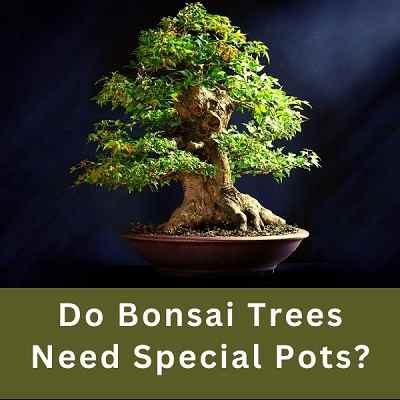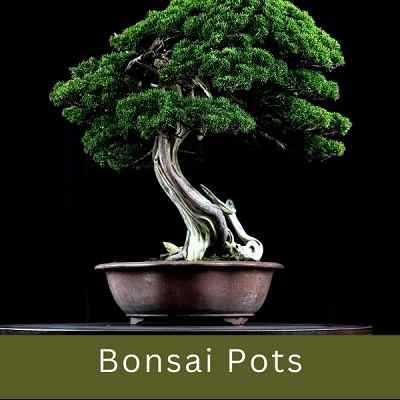Bonsai trees need special care to grow. The correct container is frequently disregarded in bonsai maintenance. People often ask whether bonsai trees require special pots or if any container would suffice. We’ll discuss how bonsai tree pots effect development and health in this blog article.
Should Bonsai Pots have holes? Yes, A bonsai tree must have drainage holes and they generally do not need any special pots but yes container should be high quality. Drainage holes prevent water from accumulating in the pot and suffocating the roots that way Bonsai live longer. Best Pots with holes can be made of Ceramic, concrete, plastic, and metal pots are available (although some metals may release toxins).
The significance of drainage holes in bonsai pots is emphasized in every professional source on bonsai maintenance. According to Bonsai Yard, drainage holes play a key role in a bonsai tree’s ability to breathe, establish roots, and maintain root health. In order to prevent root rot, maintain excellent aeration, and enable the plant roots to develop correctly, Plant Paladin also verifies that bonsai pots need drainage holes.
The subject of pots without drainage holes has also been discussed extensively on the Bonsai Empire forum. The common belief is that you must have those holes in your pots, and it is advised that you drill some holes if there are none already. No holes in the pots are bad for any plant, according to Bonsai Nut, and if your plant holds too much moisture, it might result in rotted roots in the soil.
Buy bonsai pots with holes from the links below :
Bonsai Outlet Training Pots with Humidity Trays
Round Unglazed Ceramic Bonsai Pot
| Specification | Description |
|---|---|
| Plant | Bonsai Tree |
| Issue | Proper drainage and pot selection |
| Importance of Drainage Holes | Necessary to prevent water from accumulating in the pot and suffocating the roots |
| Pot Material | Can be ceramic, concrete, plastic, or metal |
| High Quality Container | Recommended for long term health of the plant |
| Metal Pots | Some metals may release toxins, so care should be taken when selecting a metal pot |
| Environment | Bonsai trees can be grown indoors or outdoors, depending on the species and climate |
| Appearance | Miniature tree with a unique shape, size, and color |
| Light Requirements | Varies depending on the species |
| Water Requirements | Varies depending on the species, but generally requires regular watering with well-draining soil |
| Soil Requirements | Varies depending on the species, but generally requires well-draining soil with appropriate nutrients |
| Maintenance | Requires regular pruning, watering, fertilization, and repotting as necessary to maintain health and shape |
What is Bonsai Tree?
The ancient Chinese art form of pénjng gave rise to the Japanese and East Asian practice of cultivating and nurturing small trees in pots known as bonsai. The practice of growing miniature trees that resemble the size and proportions of larger trees observed in nature is known as bonsai. To retain their tiny size and aesthetic appeal, these trees are meticulously shaped and trimmed while being cultivated in containers, such as shallow pots.
Any kind of tree or plant that can be grown and sculpted in the Bonsai style is considered to be a bonsai tree. Among the popular species utilized for bonsai are pine, juniper, maple, and elm. Due to their hardiness and ability to be sculpted into practically every known Bonsai form, pine trees are especially well-liked for bonsai.
Bonsai tree care demands a significant lot of perseverance, commitment, and expertise. These trees need particular soil, water, and light conditions, therefore they must be carefully watched after and cared for. In order to maintain their small stature and aesthetic appeal, Bonsai trees also need regular pruning and shaping.
As they have been grown for thousands of years, bonsai trees have gained appeal all around the globe. According to a person’s culture or beliefs, bonsai trees might represent luck, harmony, balance, or any number of other qualities. Many people only use them as ornamental items to infuse their homes or gardens with a touch of the natural beauty.

Which type of pots are suitable for bonsai making?
Ceramic, concrete, plastic, and metal bonsai containers are available. As an AI language model, I have no choice, yet certain metals produce poisons. Classic Bonsai pots are stoneware-burned ceramic or porcelain, so they don’t absorb or contain water.
Bonsai pots should be circular, hexagonal, or square with a 25–30 cm diameter. Bonsai hues include mosaic, sky blue, terra cotta, grey, and jungle green. Your Bonsai tree’s root system needs a container big enough to expand.
Bonsai plants need various pots too. Straight-trunk trees flourish in rectangular pots, but curved/soft-lined Bonsai perform best in circular pots. Angular containers suit heavy bonsai, whereas circular pots suit delicate ones. A well-chosen container will improve a bonsai and strengthen its design, while an improper pot may actually weaken the tree.
Why are bonsai in shallow pots?

With bonsai trees, shallow containers retain the roots and branches and restrict development. With fewer roots and soil, bonsai trees develop slowly. Planting a “finished” bonsai in a small pot helps keep its form. Bonsai trees must be trimmed and trained to acquire the desired form.
Shallow pots enable bonsai trees that look like landscape trees seem larger. Cascade and semi-cascade bonsai resemble mountains. The little container complements the miniature plant, which resembles a full-grown tree. Bonsai pots are smaller.
The small container prevents bonsai roots from spreading and gives the tree’s branches more space. It helps bonsai develop into a full-grown tree in a short place.
Do bonsai pots need holes?
Drainage holes in bonsai pots prevent excess water from rotting roots. Conventional bonsai pots feature at least one drainage hole, but two to four holes are best.
To make tree maintenance simpler, drill one or two drainage holes into your bonsai container. Drainage holes allow proper soil aeration and oxygenation for healthy bonsai.
Do bonsai plants need big pots?
A bonsai container should be big enough to let the tree’s roots develop. The container should be the same height as the trunk is broad above the surface roots. The container should match the tree’s size.
Oval and rectangular pots are generally 2/3 the tree’s height. Root ends need space to absorb soil nutrients and moisture. Small pots restrict root growth, limiting oxygen and food intake. Nevertheless, a huge container might cause waterlogging and stagnant soil, which can harm the tree.
What happens if you don’t repot bonsai?
Bonsai trees need frequent repotting to be healthy and alive. Pot-bound bonsai trees have tangled roots and nutrient-depleted soil. This causes stunted growth, poor health, and tree mortality. Repotting your bonsai every 1-3 years, depending on age and growth pace, prevents this.
To stimulate feeder roots, gently trim bigger roots while repotting. Bonsai trees need fertilizer and water, which these little roots absorb better. The perfect size and shape container will help your tree grow and flourish. Repotting your bonsai frequently helps it thrive and develop into a beautiful, healthy tree.
When should you not repot a bonsai tree?
Repotting bonsai plants requires time for success and health. Bonsai trees should not be repotted in winter or summer due to dormancy and stress. Instead, repot your bonsai tree in early spring before growth starts. The tree is developing and its roots will recover rapidly following repotting. Early spring repotting lets the tree adjust to its new container before summer heat. This establishes the plant and prepares it for summer heat. Use the right potting material, repot properly, and care for your bonsai tree thereafter to keep it healthy.
How do you repot a bonsai for beginners? (Step by step Guide)
Bonsai plants need repotting to be healthy. That might be daunting for novices, but it’s necessary for tree growth. This article will walk you through repotting a bonsai tree.
1: Timing
Bonsai should be repotted in early spring or late winter. While the tree is dormant, it may recover swiftly.
2: Preparation
Choose a somewhat bigger pot. Drainage holes prevent water from pooling in the pot. Make potting media from soil, sand, and peat moss. Your bonsai tree needs the correct soil type.
3: Tree removal
Gently unpot the tree. A root hook or chopstick may gently release the roots to extract the tree from the earth. Protect healthy roots.
4: Root trimming
Cut lengthy or thick roots, keeping as many healthy roots as possible. The tree adapts to the new potting material and grows new roots.
5: Tree placement
Adjust the tree’s height in the new container. For optimal results, place the tree in front of the pot. Align the tree.
6: Planting the tree
Press the potting media around the roots as you fill the container. Let the tree to drain.
After Care
The tree should recuperate in shade after repotting. Let the tree to acclimate before watering. Give the bonsai enough light, water, and nutrients to flourish.
Repotting your bonsai tree is necessary for its health. You can grow your bonsai with patience and the correct equipment.
Bonsai Tree Overall Care
To grow, bonsai plants need special care. Your bonsai will develop and remain healthy with these advice.
Bonsai trees need light, but not direct sunshine. For many hours a day, place your bonsai in bright, indirect light. The finest windows are east-facing.
Water: A bonsai’s water needs vary on its species, pot size, soil type, temperature, and light exposure. Bonsai should be watered when the top inch of soil is dry. Let the pot to drain after watering.
Bonsai plants need fertilizer to grow well. Throughout the growth season, use a slow-release or half-strength liquid fertilizer every two weeks. Fertilize less in winter.
Temperature: Most bonsai plants need daytime temperatures of 60-75°F and nighttime temperatures of 45-60°F. Don’t shock your bonsai with excessive temperatures.
Humidity is essential for bonsai plants. Use a humidity tray or mist your tree daily to keep it wet.
To keep your bonsai tree in form, prune it regularly. Employ sharp, clean scissors or shears to cut undesired growth like new shoots or leaves.
Additional needs: Your bonsai may require more than light, water, fertilizer, temperature, humidity, and trimming, depending on the tree type. Certain plants need particular soil types or repotting every few years. Learn your bonsai tree’s requirements to keep it healthy.
You can keep your bonsai tree healthy and thriving by following these maintenance and growth suggestions. Remember that bonsai trees need special care, but with patience and attention, they may become attractive additions to your home or yard.
Final Words
In conclusion, your bonsai tree’s health and development depend on its container. Size, substance, and form may impact the tree’s soil absorption. Your bonsai’s size, kind, and soil must determine its pot. With the appropriate container and care, your bonsai tree will blossom and beautify your house for years.
How to Grow Lavender in Pots? – Planting Guide in Containers
